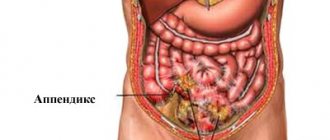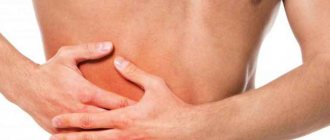What can you eat after surgery?
In the first minutes of recovery from anesthesia, the patient asks to drink, so it is allowed to give some boiled water, but in small portions. If this amount does not cause vomiting, then this volume of liquid can be increased. In case of an uncomplicated surgical period, from the second day the patient is prescribed a menu that looks like this:
- 1st and 2nd days - thin porridge, vegetable puree, you can drink milk and jelly. If the patient is unable to eat on his own, then honey. the staff helps him, because at this stage it is necessary to eat so that the stomach and intestines begin to work.
- Day 3 - the same, but with the addition of black bread and butter.
- 4th day - if the patient feels well, you can switch to a regular diet.
In conclusion: although appendicitis is an organ of the immune system, if purulent inflammation develops, it must be removed immediately, because the process will then spread to surrounding tissues. Never ignore the first symptoms of the disease, and do not be afraid of medical intervention, because if you follow the rules in the postoperative period, you will never have complications, and only a scar from appendicitis will remain as a keepsake.
Recovery from appendicitis is one of the main issues that occupy patients' minds when they are faced with the need to remove an inflamed appendix. It is worth preparing for the fact that rehabilitation will take some time, during which physical activity will have to be canceled and the usual way of life will have to be changed somewhat. Experts have compiled their recommendations and answers to questions: how long does rehabilitation last after appendicitis removal?
Wound healing and scar formation
A suture after appendicitis is the result of an appendectomy. After surgery, a scar remains on the patient’s abdominal wall that requires care. It consists of two seams: external (cosmetic) and internal. The first one heals faster.
After the external suture has fused, a hard scar 12 cm long is formed. If no complications arise in the postoperative period, a flat scar will remain on the skin. Otherwise, the scar will increase and the seam will become convex.
The internal suture after appendectomy connects the tissues of the abdominal wall and mesentery. It is formed with a surgical self-absorbing thread and does not require special care. It resolves within 1.5 months.
The scar is clearly visible in the first two weeks after surgery. A common complaint from patients is that the suture after appendicitis is hard and dense. There is no cause for alarm: this is due to the formation of connective tissue.
The characteristics of the scar depend on how the operation was performed:
- With a classic cavity appendectomy, the length of the scar is 7-8, and sometimes 10-12 cm. Healing lasts 1-3 months and more in case of complications. After final healing, a visible scar remains. Initially it is pink, but gradually fades. Complete regeneration of epithelial cells lasts for a year.
- During laparoscopy, 3 sutures are applied, each 1.5-2 cm long. They heal quickly, within 2-4 weeks.
After laparoscopy, a barely noticeable cosmetic scar is formed. You can later get rid of it using laser removal.
It is impossible to give a definite answer to the question of how much the stitch hurts after appendicitis. A characteristic feature of scars left after abdominal surgery is pain when pressing, touching, or wearing tight clothing, even after complete healing.
In addition to the pain of the scar after surgery, other unpleasant sensations arise: itching, swelling, a feeling of tightness in the incision area.
What determines recovery time?
First of all, the recovery time after surgery and removal of the appendix depends on the complexity of the situation. If a purulent version of the disease develops or even gangrenous appendicitis develops, turning into peritonitis, it will take much longer to recover.
This is due to the fact that the presence of pus inside the body indicates some kind of infection. And fighting infection takes much longer than simply cutting out the inflamed appendix. After all, everything needs to be washed thoroughly, without leaving a drop of pus. Then you will have to carry out antibacterial therapy to eliminate all the symptoms of inflammation.
Because of this, physical activity is quite limited and is allowed only in those volumes and in the form in which they will help prevent bedsores. All others after a complex removal of the appendix, for example, if there was a gangrenous variant of the disease, are prohibited for a long period - until complete recovery.
In addition, recovery also depends on the type of surgery used to treat the problem. Today, doctors often distinguish two types of operations:
- Laparoscopy
- Full abdominal surgery
So, for example, in an uncomplicated form, when only the inflamed organ is removed, which has not yet had time to burst, a simpler and less traumatic laparoscopy is used. It simply involves the creation of several holes through which the damaged appendix is removed. The healing time and tissue restoration after such an operation is about several weeks, a maximum of a month.
If we talk about what rehabilitation should be like after abdominal surgery, it will take many times longer and can last up to six months.
It is worth understanding that appendicitis, for which the postoperative period takes a long time, requires careful recovery so that the body is 100% ready for complex loads.
When to go to work
According to official medical standards, 2 weeks are allotted for the healing of a suture after appendicitis. Over the next 2 weeks, the body fully recovers. The total is 4 weeks, but these are averages. Sick leave for laparoscopy is issued for 5-10 days. After a complex abdominal operation, they are released from work for 15-30 days. If the postoperative period is aggravated, sick leave is extended for more than 30 days until complete recovery.
Recovery after removal of the inflamed appendage of the cecum takes 4-6 weeks. During this time, damaged skin and muscles grow together. To facilitate the post-operative interval and speed up healing, follow the doctor’s recommendations, take the necessary medications, and adhere to a diet.
We recommend: Appendicitis under anesthesia or not - types and advantages
For what reasons is it necessary to endure the full rehabilitation period?
The full recovery period must be maintained so that no complications arise. This is especially important if there were such complicated variants of the disease as purulent, gangrenous, phlegmonous and others. Indeed, in this case, the body is seriously depleted both by the disease itself and by surgical intervention, anesthesia and other elements.
During physical activity, carrying heavy objects, a person has to strain the peritoneum. Namely, the abdominal cavity suffers to the maximum during the operation. And if you start exercising at the wrong time, there is a risk that the stitches will come apart or some other serious problems will appear, which will further delay the healing process.
Gangrenous appendicitis can also be quite dangerous, because... tissue death begins. And in this case, you have to be especially careful about physical activity.
What measures are taken on the first day after surgery?
On the first day after the operation, doctors must evaluate a number of parameters in the patient, which indicate how correctly the recovery process begins (and it begins immediately after the end of the surgical intervention). Signs include:
- Detoxification of the body (if such a measure is necessary)
- Monitoring for signs of bleeding
- Monitoring the patient’s condition (temperature, pressure, condition of sutures and much more)
- Checking the restoration of physiological characteristics
On the first day after surgery, and better yet on the second, everything must be maintained very carefully in order to avoid the development of serious complications. It is worth understanding that in this case there is a high risk of developing peritonitis and other problems.
Doctors give their recommendations on the correct implementation of rehabilitation measures. At a minimum, the rehabilitation period should be 4 weeks. Moreover, at this time you should very carefully monitor the condition of your suture and the body as a whole. There should be no fever, redness, itching, and especially no discharge. If such alarming symptoms appear, you should consult a doctor immediately.
It is worth considering that children and patients who are quite heavy take many times longer to recover from surgery.
In the absence of complications and after maintaining a 4-week period, doctors advise proceeding to the following points of recovery. The patient can begin walking short distances. Visiting the pool with light and inactive loads is allowed.
To avoid problems, it is advisable to use a special bandage. This rule is especially relevant for overweight people, because... Due to excess fat and the weight of the tissues, they have a risk of tissue divergence.
Recovery from appendicitis: diet and physical activity

Appendicitis is a disease that affects adults and children without exception, but women are more likely to suffer from it. The only treatment method is surgery, and the faster it is, the better. Recovery from appendicitis is no less important in the process of complete recovery than the surgical intervention itself.
Indeed, if certain rules are not followed, the patient may end up on the operating table again, and the return to normal everyday life will have to be postponed indefinitely.
To avoid problems and return to your normal lifestyle as soon as possible, it is important to take a responsible approach to rehabilitation after appendicitis removal.
Diet as an important stage of recovery
Naturally, full rehabilitation after appendicitis is impossible without following a certain kind of diet. Doctors even claim that dietary restrictions play a key role. After all, failure to follow a diet can easily lead to sutures coming apart and even the development of purulent inflammation.
Immediately after the operation you cannot eat, only water is allowed (it must be clean, potable and always without gas). Next, you will have to eat sparingly for several days. That is, food should be as easy to digest as possible, ideally ground. The use of jelly is also allowed. You definitely need to eat something that will normalize your intestines.
- Broth – always low concentration
- Freshly pressed juice, but always diluted with water to reduce its acidity
- Herbal teas, rosehip infusion or black tea (but only weak)
Then, after 2 days, you can introduce the following products gradually and very carefully:
- Steam porridge
- Puree soups
- Fermented milk products with low fat content
- Steamed vegetables and fruits
- Lean meat
But from traditionally unhealthy dishes:
- Pickles
- Smoked meats
- Marinades and others
I'll have to give it up during rehabilitation. If you follow all these recommendations, recovery will be as easy and quick as possible.
Rehabilitation after appendicitis lasts about two months, during which the patient must adhere to certain restrictions. Its duration depends on the general health of the patient, his age and the presence of complications before or after surgery.
The first days after appendectomy, bed rest is required
Young and middle-aged people who adhere to an active lifestyle recover faster. Children and overweight patients take longer to fully return to normal life.
Timing for suture removal
When sutures are removed after appendicitis in adults, attention is paid to its condition. Healing is indicated by the appearance of a crust on top. The seam can be removed if it is painted a uniform color over its entire length and there are no discrepancies, compactions, or nodules.
Under normal conditions, it is removed 7-10 days after appendectomy. The period of removal depends on the speed of healing of the wound surface. If pus is found in it, drainage is placed. To do this, a tube is placed inside the wound, the ends of which are brought out.
After the procedure, the patient goes home, where he continues rehabilitation. Patients are concerned about how long it takes for a suture to heal after appendicitis. Complete tissue restoration after appendectomy occurs within six months.
First days after surgery
Upon completion, the patient is transported on a gurney to the ward, where he will be under close supervision of medical staff to monitor the process of recovery from anesthesia. In order to prevent suffocation when vomiting occurs, which may be caused by a side effect of the drug, the patient is turned on his healthy side. If there are no complications, then 8 hours after the operation the patient can sit up in bed and make careful movements. After appendicitis is removed, injectable painkillers are prescribed for several days, as well as antibiotics to prevent infectious complications.
If you follow all the doctor's recommendations, recovery after appendicitis surgery usually occurs without complications. The first day is the most difficult for the patient. The time spent in hospital, as a rule, does not exceed 10 days.
During this period the following is carried out:
- daily monitoring of body temperature;
- regular measurement of blood pressure levels;
- control over the restoration of urination and defecation functions;
- inspection and dressing of the postoperative suture;
- monitoring the development of possible postoperative complications.
When removing appendicitis, the postoperative period, namely its duration, severity and the presence of complications, largely depends on the chosen surgical method (laparoscopy or abdominal surgery).
When the right side or stomach may hurt
If after removal of appendicitis the right side hurts for a long time, one may suspect the development of undesirable consequences . Complications after the disease are varied, but if all medical recommendations are followed and the surgeon performs the operation correctly, they are extremely rare.

Chronic appendicitis
Chronic appendicitis occurs when the appendix is incompletely removed , when a stump remains at the site of excision. Over time, it becomes inflamed, the infectious process becomes sluggish, often lasting for months or even years.
Main symptoms:
- nagging pain of a wave-like nature;
- bowel dysfunction, alternating diarrhea and constipation;
- moderate intoxication during exacerbation with nausea or vomiting.
An adequate method of treatment is repeated removal of the appendix, sanitation of the abdominal organs. Additionally, antibacterial and symptomatic therapy is prescribed.
Spikes
An adhesive process occurs after any surgical intervention and is formed due to irritation of the mucous membranes and impaired mucus secretion.
After removal of the inflamed appendix, adhesions form in the intestines and peritoneal organs - thin films that appear inside the cavity lumens and peritoneal organs. Among the symptoms of the adhesive process are :
- discomfort in the lower abdomen, pain during bowel movements;
- chronic constipation, prolonged absence of stool;
- flatulence, gas formation.
To eliminate the adhesive process, most often it is enough to follow a diet with foods rich in fiber, take osmotic laxatives and drink plenty of fluids. Its complicated course requires surgical intervention.
Interesting things on the site:
Features of laparoscopy for appendicitis
How long after appendectomy can you drink alcohol?
What can you eat after appendectomy?
Peritonitis
Inflammation of the abdominal organs and lining membranes of the peritoneum is a dangerous complication requiring emergency surgical intervention .
Symptoms of peritonitis are expressed in the following manifestations::
- nagging and then sharp pain in the right hypochondrium;
- acute intoxication: nausea, vomiting, fever;
- “acute abdomen” syndrome – upon palpation, tension in the muscles of the abdominal wall is noticeable;
- intestinal obstruction, difficulty in evacuating feces even after taking laxatives or enemas;
- increased heart rate;
- grayish complexion;
- cold, sticky sweat.
Usually, the diagnosis of peritonitis does not require additional research : an experienced surgeon identifies the complication and understands its severity upon palpation of the peritoneum.
Peritonitis as a complication of appendicitis occurs extremely rarely , but occurs in patients with autoimmune pathologies, chronic appendicitis, and violation of appendectomy technique.
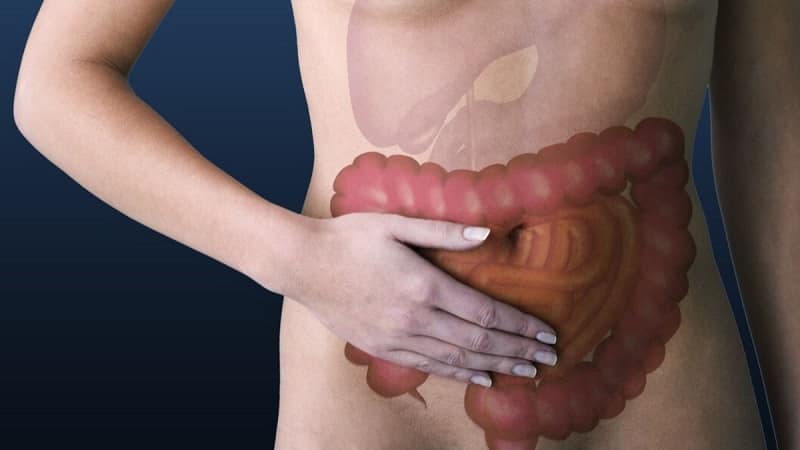
Hernia
Umbilical and inguinal-scrotal hernia are characterized by protrusion of scar tissue outward , resembling a small lump. This is due to weakness of the abdominal muscles. At risk are persons with a history of umbilical or inguinal-scrotal hernia (men), pathological weakness of smooth muscles of any nature, as well as elderly and elderly people.
Important! The main danger of a hernia is the possibility of strangulation, which is eliminated by abdominal surgery or laparoscopy; in other cases, they are limited to conservative treatment and wearing a special bandage.
Hernia symptoms:
- pain and swelling;
- bowel dysfunction;
- increased gas formation, flatulence;
- moderate dyspepsia.
Characteristic signs of a hernia are difficulty defecating, blood particles in the stool, pain in the lower abdomen after any physical activity or at rest. Complications include transient diseases of the gastrointestinal tract: enterocolitis, colitis, paraproctitis, etc.
Heart rhythm disturbances, shock due to acute pain due to the inflammatory process, respiratory disorders, difficulty urinating and defecating (as a side effect of certain medications), and local suppuration in the area of the postoperative scar are often observed.
Other reasons
After appendicitis, the stomach hurts for other reasons not related to the operation . Most often, pain is periodic due to physiological characteristics or existing concomitant diseases.

Nonspecific causes of pain in the right side after appendicitis:
- Ovulation in women . The ovulation period occurs 1.5-2 weeks before menstruation. Women complain of moderate nagging pain and spotting vaginal discharge even before menstruation. Pain also occurs during pregnancy.
- Gynecological diseases . Pain in the right side can be caused by ovarian cysts, tumors of any nature and morphological structure, endometriosis, and sexually transmitted infections. The clinical picture requires mandatory differential diagnosis.
- Cholecystitis . Pain on the right also occurs against the background of cholelithiasis, acute cholecystitis, inflammation of the liver and organs of the hepatobiliary system. Acute pain is often observed during exacerbation of the pathological process.
To make a final diagnosis, a series of general clinical studies are prescribed , aimed at clarifying the true cause of pain, including after appendectomy.
Nutrition after surgery
Rehabilitation after appendicitis includes following a certain diet for at least two weeks. On the first postoperative day you cannot eat; you are only allowed to drink plain and mineral water without gas or kefir with 0% fat content. On the second day, you need to start eating to restore the gastrointestinal tract. You should eat foods and feel a feeling of heaviness in the intestines. The diet should be fractional: it is recommended to eat food in small portions, divided into 5 or 6 meals.
Recommendation: In the postoperative period, consumption of low-fat fermented milk products is beneficial. They will contribute to the rapid normalization of the gastrointestinal tract and the restoration of intestinal microflora disturbed after the use of antibiotics.

Low-fat fermented milk products have a positive effect on the gastrointestinal tract in the postoperative period
Products allowed for consumption during the postoperative period
For the first three days after surgery, you need to eat easily digestible food with a jelly-like or liquid consistency. The following products are allowed:
- liquid porridge;
- liquid purees from potatoes, carrots, zucchini or pumpkin;
- rice water;
- low-fat kefir or yogurt;
- pureed boiled chicken meat;
- chicken bouillon;
- jelly and jelly.
On the fourth day, you can add black or bran bread, baked apples, pureed soups with dill and parsley, hard cereals, boiled meat and lean fish to your diet. With each subsequent day, it will be possible to further expand the list of products, gradually returning to the patient’s usual diet. The diet used must be agreed upon with the attending physician. Despite some restrictions, a complete diet rich in vitamins and minerals is necessary, since during the rehabilitation period the body needs additional support.
Drinks allowed include rosehip decoction, freshly squeezed diluted juices, compotes, still mineral water, herbal or weak black tea. The amount of liquid consumed per day should total 1.5–2 liters.
Products prohibited for consumption during the postoperative period
When discharged from the hospital, for another 14 days of the postoperative period after removal of appendicitis, it is not allowed to consume foods that lead to irritation of the mucous membrane, the formation of gases and fermentation processes in the intestines. First of all, the purpose of such a diet is to prevent rupture of internal seams and reduce the food load on the body. The following rules must be followed:
- limit the amount of salt;
- do not add spices and seasonings when cooking, as well as ketchup and mayonnaise;
- exclude legumes from the diet;
- give up rich bakery products;
- avoid eating vegetables such as tomatoes, peppers, cabbage and raw onions;
- completely eliminate smoked meats, sausages, fatty meats and fish.
During the postoperative period, it is also not allowed to drink carbonated drinks, juices from grapes and cabbage, and any drinks containing alcohol.
Recovery after surgery
As a rule, complete recovery from appendicitis occurs 2-3 months after surgery. During this period, it is important to unquestioningly follow all the recommendations of the attending physician, since the speed of complete recovery, as well as the likelihood of complications, depends on this.
In the hospital
After surgery to remove appendicitis, the patient is sent to a ward, where recovery from anesthesia will occur under the supervision of medical staff. The patient is placed on the non-operated side, since vomiting may occur when the anesthesia wears off, so the “supine” position is undesirable. If no complications are observed, then after a while they are allowed to slowly and carefully turn in bed. In the first couple of days, antibiotics are indicated to prevent the possibility of developing infectious complications.

The postoperative period after removal of appendicitis in a hospital lasts up to two weeks (in the absence of complications). Medical staff regularly perform the following manipulations to monitor the patient’s recovery process:
- daily measurement of body temperature and blood pressure;
- control, treatment and dressing of postoperative suture;
- observation to identify possible complications (adhesions, hernia, re-inflammation);
- control of bowel movements.
The first day after removal of appendicitis, the patient is prohibited from eating; only 6 hours after the operation can he gradually drink plain water.
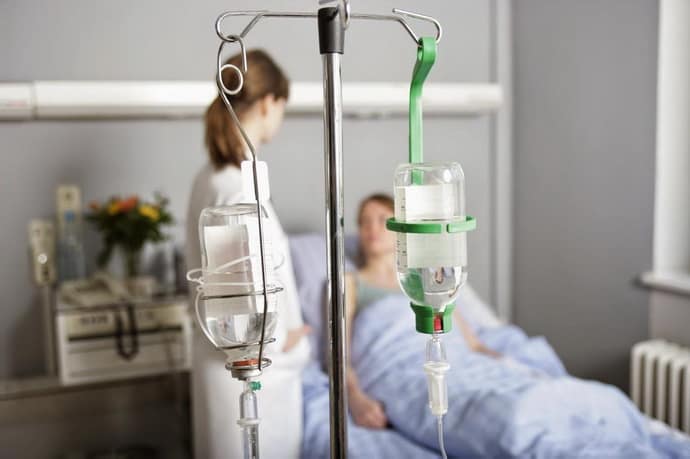
On the second day, you can eat low-fat chicken broth with soaked crackers. In the future, you can diversify your diet, while avoiding foods that disrupt bowel movements and cause flatulence and bloating.
Removal of external sutures, in the normal course of rehabilitation, is carried out on the 10th day, while internal sutures dissolve on their own within a couple of months. Discharge from the hospital occurs on the 7th–10th, less often on the 14th day after the operation.
Diet
After appendicitis surgery, for a speedy recovery and prevention of complications, patients are advised to follow a gentle diet. The first days after surgery consist of broth, pureed porridge and liquid puree. Subsequently, other foods are introduced into the diet.
Can be used:
- fermented milk products - cottage cheese, kefir, yogurt - all with a minimum percentage of fat content;
- dietary chicken or meat broth;
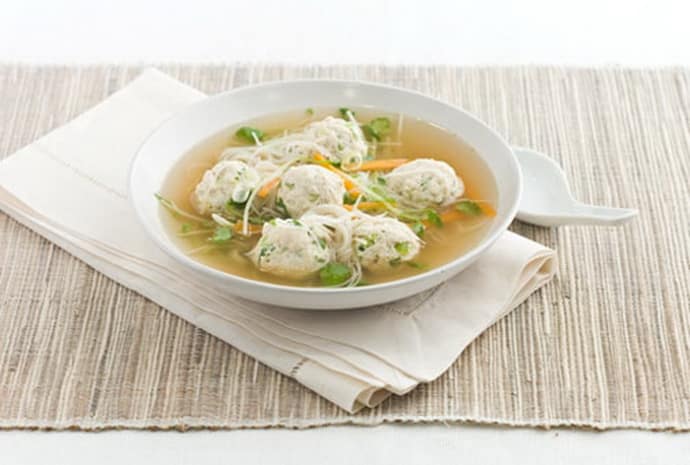
- boiled meat and fish, always pureed;
- pureed boiled vegetables;
- liquid porridge;
- compotes and jelly;
- water.
Gradually, the patient’s usual dishes are introduced into the diet, but the diet is agreed upon with the attending physician. Nutrition should be nutritious, rich in useful and nutritious substances to speed up the healing process.
While in hospital and a couple of weeks after discharge, patients are advised to avoid eating foods that can disrupt bowel function. This is done to eliminate the possibility of rupture of internal seams, as well as to reduce the load on a weakened body during digestion of food.
For a speedy recovery and prevention of complications, you must avoid the following products:
- exclude foods and dishes with a high salt content;
- refuse mayonnaise, ready-made sauces and seasonings;
- replace rich bakery products with crispbread or dried gray bread;
- give up fatty sausages, sausages, smoked and fried foods;
- legumes are prohibited;
- stop eating certain vegetables;
- do not drink alcohol or carbonated drinks.
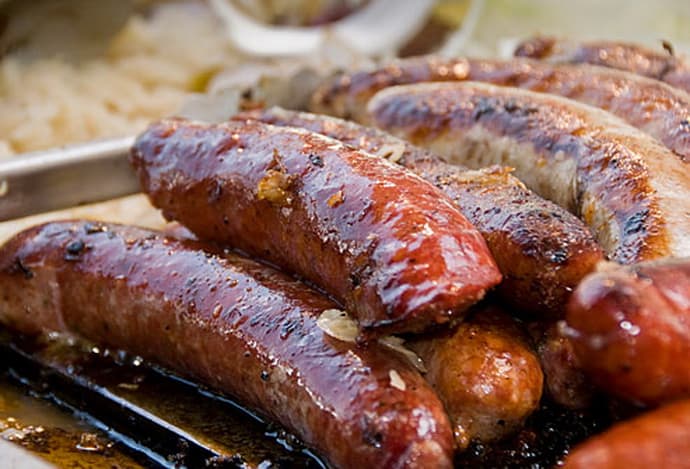
How long the diet will last depends on the patient’s condition and the rate of suture fusion. If there are complications, the period of eating dietary food will be prolonged.
Physical activity
Excessive physical activity, as well as its complete absence, is contraindicated in patients after surgery to remove appendicitis. The first days after surgery, the patient can carefully turn over in bed, and in the absence of complications, carefully stand up and walk. In the future, the patient is prescribed exercise therapy to prevent the formation of adhesions.
For the first 8 weeks after discharge, to speed up recovery, patients can take leisurely walks and continue doing therapeutic exercises. Full physical training, lifting objects heavier than 3 kg, and fast walking are prohibited.

Failure to follow these recommendations can delay the healing process and also provoke complications - incomplete healing due to constant tissue divergence, hernia.
Full physical training is possible no earlier than six months after all the seams have completely fused.
Other factors
Rehabilitation after appendicitis includes not only dietary nutrition and moderate physical activity, but also control in other normal areas of life.
- For example, until wounds are completely healed, it is forbidden to swim or take a bath, as the risk of infection is high. Instead, the patient can wipe himself with a damp towel, or wash himself partially. In this case, the scar on the abdomen should be protected from moisture.

- Baths and saunas are prohibited for a month. You can go to the pool only after healing of not only the external, but also the internal sutures, since there is a high risk of dehiscence, and as a result, the formation of a hernia.
- Tanning and visiting a solarium are also prohibited, as exposure to ultraviolet radiation on the operated area should be avoided. In the future, tanning is allowed, but the scar area will still have to be covered from direct exposure to sunlight.
- Smoking and drinking alcohol should also be avoided. And if you should not drink alcohol for a couple of months, then you can resume smoking a week after the operation.
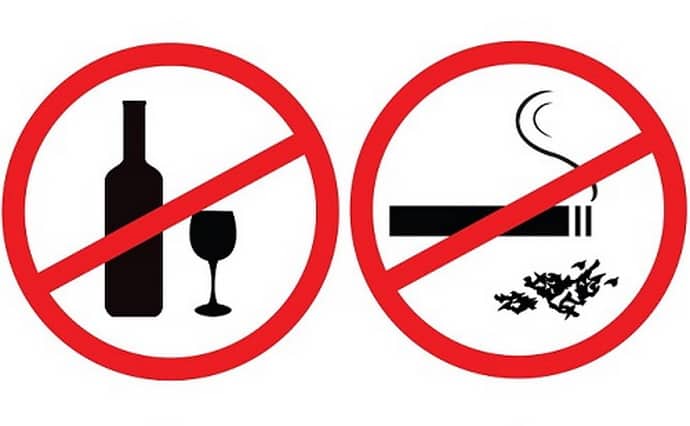
- You can return to a full sexual life after the stitches are removed, while the patient should take a passive position and not strain the abdominal muscles. In case of appendicitis with complications, the return to full sexual activity will have to be postponed for some time - until the wounds heal.
- Wearing a bandage to support the abdominal muscles is recommended in the first days after surgery, and overweight people and children should wear the bandage as long as recommended by the attending physician.
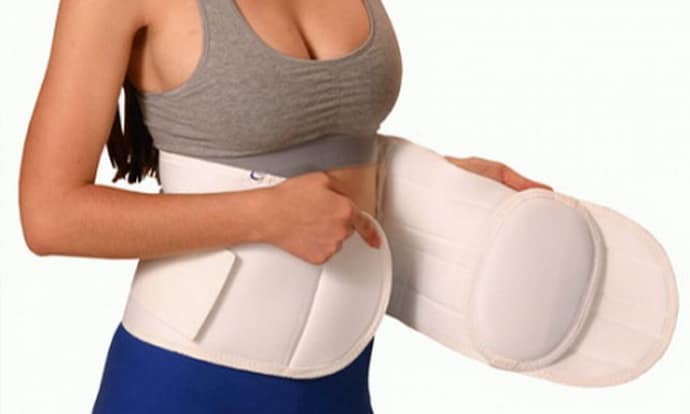
The above recommendations are not difficult to implement, but some patients, having felt the first relief, immediately begin to strain the weakened body. Failure to comply with rehabilitation rules is fraught with complications.
Physical activity in the postoperative period
During the rehabilitation process after appendectomy, it is necessary to adhere to certain restrictions on physical activity. This will speed up recovery and minimize the risk of possible complications. You are allowed to get out of bed and start walking three days after the operation. During the initial recovery period, it is recommended to use a support bandage, especially for overweight patients.
Tip: to prevent the sutures from coming apart, it is recommended to hold your stomach when making sudden movements such as sneezing, coughing, or laughing.
A sedentary lifestyle during the rehabilitation process is no less dangerous than high physical activity. It can cause the formation of adhesions, poor circulation, or the development of muscle atrophy. In this regard, almost immediately after the operation, in agreement with the doctor, in a supine position, it is recommended to perform a special complex of exercise therapy.
In the first two months, physical activity should be limited to daily walking and therapeutic exercises. During this period, it is prohibited to carry or lift weights weighing more than 3 kg. After 14 days after surgery, if there are no contraindications, you are allowed to resume sexual activity. When the postoperative scar has completely healed, a visit to the pool is recommended.
You can learn more about nutrition rules after appendectomy from the video:
Removal of appendicitis has long been recognized as one of the safest and easiest operations, which can be easily tolerated by both adults and children. However, errors cannot be ruled out here either: during the surgical intervention itself and in the postoperative period. Therefore, it is so important to know all the rules and stages of treatment of acute appendicitis after surgery - this will help to avoid complications and return to normal routine as quickly as possible.
Treatment after surgery to cut out appendicitis (appendectomy) does not have a specific time frame - it is individual for each patient. How many days does recovery after an appendectomy last on average? Usually this is one and a half to four weeks; for children under 10 years of age, the elderly and obese people, the time increases. Young and slender patients return to their usual rhythm of life much faster.
If no complications arise in the first 3-7 days after excision of the appendix, the patient is discharged, explaining the basic rules for further behavior. It is on their strict adherence that it depends on how many days a person will be able to live a normal preoperative life.
- Every day you need to walk short distances in the fresh air.
- You can go to the pool and play sports only when a scar has formed after appendix removal (up to 2-6 months).
- Lifting weights is prohibited for the first 2.5-3 months after appendicitis is removed.
- Overweight patients and active sports people are recommended to wear a bandage for 3-7 days after surgery, and for several more months during any physical activity.
- Sexual activity is allowed 2 weeks after surgery.
The concept of the postoperative period
The postoperative period is the time from the end of the operation to the complete restoration of a person’s vital functions and lost ability to work.

After removal of appendicitis, the patient's body needs to adapt to the new anatomical and physiological relationships created by the operation. The completeness and duration of his recovery directly depends on this time. Rehabilitation is a very important and necessary moment that every patient must go through. The postoperative period is divided into early, when the patient is in the hospital, and late, when recovery occurs at home.
For a quick recovery, the patient after surgery to remove appendicitis needs to be under the dynamic supervision of a doctor and other medical professionals. This is carried out with the aim of timely detection and treatment of possible complications. For this purpose, the patient is immediately placed in a separate room after the operation, where he is monitored. While the person undergoing surgery is in intensive care, visits to him are, as a rule, prohibited. There they monitor the condition of the skin, postoperative suture, consciousness and body temperature, as well as a number of specific indicators, such as: blood pressure, heart rate, respiratory rate, diuresis, blood test. Their study is carried out after surgery. In critical conditions, continuous recording of the electrocardiogram and hemodynamic monitoring are required.
In the first hours after appendectomy, a person comes out of anesthesia. At this time, adults and children experience a number of reactions that occur under the influence of narcotic drugs: the patient may sing, laugh, scream, cry. There is no need to be afraid of this, because subcortical structures are excited when the cortex is inhibited. This is an effect of the anesthesia medication and can also cause nausea and vomiting. Therefore, after surgery, place the patient so that the head is turned to one side.
In the late postoperative period, great efforts for rehabilitation are required on the part of the patient, because at this time his tissues are restored not under the supervision of qualified specialists, but under his personal supervision. It is mandatory to follow the doctor's recommendations. This will be the key to a speedy recovery. Failure to comply with these rules is the cause of complications and repeated visits to the hospital.
A prerequisite for a favorable outcome during the rehabilitation period is adherence to a special diet and standardized physical activity. This will reduce the load on the injured intestinal tract, improve digestion, blood circulation and metabolism.
The first day after appendectomy
In the first 48 hours after surgery, patients are not given any special treatment - the main emphasis is on recovery measures: physical therapy, diet, and painkillers if necessary.
A standard operation to cut out the appendix takes 30-40 minutes, then the patient is transferred to the ward. How many days later can I go home? Official sick leave after an appendectomy usually does not exceed 2 weeks; after 3-4 days of hospitalization, the patient can be released for outpatient treatment.
The most important 24 hours in the rehabilitation process are immediately after an appendectomy. Surgical removal of the appendix is usually performed under general anesthesia, and in the first hours after the operation it is especially important to ensure proper recovery from anesthesia. The biggest health hazard during this period is vomiting. To prevent vomit from entering the respiratory tract and causing pneumonia or suffocation, the patient should be placed on the right side at the first urge.
Any food or heavy drinking is prohibited for 12-24 hours after waking up. If there are no contraindications, you can give boiled, still mineral water or weak tea with sugar every 20-30 minutes - 2-3 teaspoons at a time.
Restrictions and prohibitions in the postoperative period
For the first 24 hours after surgery, patients must strictly adhere to strict bed rest. After how many hours can you move and walk? For 8-12 hours you need to lie motionless in bed, then you can sit up and turn around, after 24 hours you can get up and slowly move along the corridors (in consultation with the doctor!).
Eating is allowed every other day, provided that the patient does not experience bouts of vomiting. For the first 8 days, it is important to follow a strict postoperative diet, then you can gradually return to your usual diet.
Increased physical activity is strictly prohibited for several days, but physical inactivity is also very dangerous - it can provoke constipation, muscle atrophy, congestion in the lungs, and disturbances in blood and lymph flow. The ideal solution is special therapeutic exercises after acute appendicitis.
Sutures after appendectomy are removed on days 4-8, but only a couple of months after surgery can you swim and engage in athletics (running, dancing, jumping, etc.). When 3-6 months have passed and the scar is fully formed, heavy physical activity is allowed.
Acute appendicitis after surgery: recovery time and general recommendations
Treatment after surgery to cut out appendicitis (appendectomy) does not have a specific time frame - it is individual for each patient. How many days does recovery after an appendectomy last on average? Usually this is one and a half to four weeks; for children under 10 years of age, the elderly and obese people, the time increases. Young and slender patients return to their usual rhythm of life much faster.
If no complications arise in the first 3-7 days after excision of the appendix, the patient is discharged, explaining the basic rules for further behavior. It is on their strict adherence that it depends on how many days a person will be able to live a normal preoperative life.
- Every day you need to walk short distances in the fresh air.
- You can go to the pool and play sports only when a scar has formed after appendix removal (up to 2-6 months).
- Lifting weights is prohibited for the first 2.5-3 months after appendicitis is removed.
- Overweight patients and active sports people are recommended to wear a bandage for 3-7 days after surgery, and for several more months during any physical activity.
- Sexual activity is allowed 2 weeks after surgery.
Therapeutic exercises after appendicitis
A set of physical therapy exercises (PT) after acute appendicitis is recommended for patients of all ages - this is an excellent prevention of congestion, intestinal paresis, thrombophlebitis, pneumonia and intestinal adhesions. How many days does a physical therapy course last? It is necessary to do gymnastics after appendectomy for the first 3-4 days after the operation, while the patient is on bed rest, then in consultation with the attending physician.
All exercises are performed from the starting position “lying on your back”, the number of approaches is 5-6 times.
- Legs lie straight on the bed, arms along the body. Flex and straighten the ankle joint of both legs.
- Legs straight, arms bent at the elbows. Bend and straighten your fingers into a fist.
- Legs bent at the knees, place one hand on the chest, the other on the surgical suture. As you inhale, pull your stomach in, and as you exhale, push it out.
- Legs straight, hands raised to shoulders. Alternately perform circular movements with the shoulder joint - forward and backward.
- Legs lie straight, hands on shoulders. Bend your knees and straighten them, your heel should slide along the bed.
- Legs are together, the left arm is extended along the body, the right arm lies on the stomach, on the surgical suture. As you inhale, raise your left arm up, and as you exhale, lower it.
The most important diet rules after appendix removal
Treatment after appendix removal primarily involves following a gentle diet. A special treatment menu will reduce the burden on a weakened body, restore and give strength, and also prevent problems with stool and other complications.
To make recovery after acute appendicitis as easy as possible, it is important to follow the rules of the postoperative diet.
You need to eat fractionally: in modest portions 5-6 times a day. This will reduce the load on the intestines, and the patient simply will not have time to get hungry. For the first 2-3 days after acute appendicitis, no solid food: only liquids, porridge, jelly and puree. Food should not be ice cold or very hot - this irritates the already weakened intestines. The basis of the menu is drinks, pureed and steamed food.
All patients are concerned with the question: after how many days can they again eat sweets, fried foods, salty foods, smoked foods and alcohol, and add their favorite spices to food? Doctors definitely recommend completely abstaining from junk food and drinks for 2-3 weeks, and then gradually introducing them into the diet - up to 2 months.
Features of the diet after acute appendicitis
How many days should the therapeutic diet last? It is necessary to return to a normal diet in stages: for the first day after surgery you will have to do without food at all. On the 2-3rd day, the basis of the hospital diet should be liquid porridge, chicken broth, pureed vegetable purees and jelly, rosehip infusion and rice infusion.
Then you can add bread, steamed chicken cutlets, light vegetable soups, steamed omelettes, low-fat sour milk, and fruit after 4-5 days to the menu.
For the first three days after removal of the appendix, any solid food, milk, pea and bean soups, potatoes, grapes, fresh cabbage, and foods high in fiber are prohibited.
For 2-3 weeks you will have to completely forget about alcohol, sausages, sweets and cakes, fatty and smoked foods. Any homemade preparations, marinades and canned goods will also have to be hidden away. It is necessary to give up strong tea, coffee and soda - they are replaced by still mineral water, weak tea, herbal infusions, jelly, fruit and vegetable juices.
After 2-2.5 months, you can completely return to the pre-operative menu and favorite dishes.
Possible complications after surgery
Typically, appendectomy occurs quickly and without serious consequences for the patient, but there are exceptions. Complications, as a rule, arise after surgery with advanced appendicitis with peritonitis, non-compliance with rehabilitation rules in the first days and weak immunity of the patient.
- Acute appendicitis can cause the following complications:
- Wound infection – pus, formation of inflammatory infiltrate, abdominal wall abscess.
- Large blood loss, as a result, interruptions in the functioning of the cardiovascular system.
- Peritonitis (inflammation of the peritoneum).
- Intestinal adhesions and postoperative hernia.
- Respiratory system disorders - bronchitis and pneumonia.
- Constipation, bloating, gas and urinary retention.
- Intestinal fistula is a hole in the wall of the intestine through which its contents (bile, feces, undigested food) are thrown out.
Fever after appendectomy
An increase in temperature to 38º is a very common occurrence after an appendectomy. It can be a natural reaction of the body or signal possible complications - it all depends on how many days the temperature lasts.
The main causes of fever after acute appendix:
- Infection due to non-compliance with sanitary rules.
- Damage to internal organs during appendectomy and the development of inflammation.
- A sharp decrease in immunity.
- Severe blood loss.
- Reaction to the installation of a drainage tube.
The norm is to maintain an elevated body temperature for up to 3 days; if the fever lasts longer and is accompanied by severe chills and increased sweating, additional treatment is prescribed.
- A course of antibiotics (depending on the causative agent of the postoperative infection).
- Antipyretic drugs (aspirin, paracetamol, etc.).
- Anti-inflammatory drugs (ibuprofen, etc.).
- In emergency cases, additional surgical intervention is required.
Treatment of complications
Serious complications after acute appendicitis occur in 5-10% of all cases and require serious comprehensive treatment. How many days after surgery do such dangerous consequences appear?
Suppuration of the wound, the appearance of infiltrate and abscess usually make themselves felt on the 3-4th day after removal of the appendix. The main symptoms are pain, fever, problems with bowel movements, noticeable swelling in the scar area). Treatment involves novocaine blockades, antibiotics, and physiotherapeutic procedures. If the outcome is favorable, the inflammatory process stops after 2-3 days.
For pulmonary and cardiovascular complications, therapeutic exercises, antibiotics, and inhalations are necessary. For intestinal fistulas, conservative treatment is also used; vacuum therapy is also effective.
The most dangerous consequence of acute appendicitis is peritonitis. It occurs quite rarely and only in destructive forms of the disease. The main symptom is persistent pain after surgery, followed by nausea and vomiting, dry mouth, gas and bloating, and constipation. There is only one treatment in such cases - repeated surgery.
Acute appendicitis is a fairly common disease. If you contact a surgeon in time and follow all medical recommendations in the postoperative period, the recovery process will go as quickly as possible. However, in advanced cases, the disease can cause complications, and how many days the recovery will last will depend only on the correct and complete treatment after surgery.
Appendicitis is an acute surgical disease caused by inflammation of the appendix of the cecum. It occurs equally often in children and adults, men and women. Despite the apparent simplicity of the disease (the most famous, common and “non-terrible” surgical disease) and operation (appendectomy is the first operation that surgeons learn to perform), it can lead to very sad consequences: peritonitis, sepsis, adhesive disease. As a result, recovery after appendix removal involves a number of specific measures.
Pain after surgery - normal or not?
How long does your stomach hurt after appendicitis? Normally, pain after removal of the appendix persists for up to 5-10 days, gradually subsiding against the background of adequate antibiotic therapy, antiseptic procedures and symptomatic treatment.
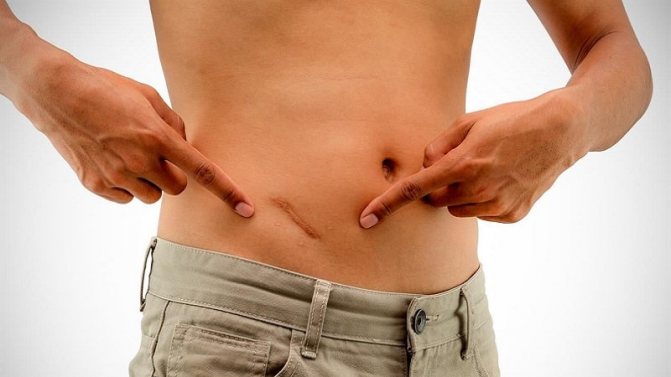
Minor nagging pain and increased gas formation in the intestines are also considered normal, which indicates a successful recovery of the body after surgery.
Reference. Normally, pain gradually decreases; at the end of the early rehabilitation period, most patients usually experience relief and are ready to return to their usual lifestyle and living conditions.
Moderate flatulence and a feeling of discomfort in the right side are considered favorable - these signs indicate a normal healing process and restoration of the functions of the lower organs of the digestive system.
Surgery for acute appendicitis causes discomfort, but the discomfort is well tolerated by patients with adequate care and good conditions for the rehabilitation period.
Symptoms of appendicitis
The main symptom of appendicitis is abdominal pain.
- Pain syndrome. Usually the pain is localized in the right groin area, which immediately suggests appendicitis. However, sometimes the disease can begin with Kocher's sign. In this case, pain appears in the epigastrium and can be relieved with drugs like No-shpa. Patients often confuse this onset of appendicitis with another attack of gastritis or chronic pancreatitis and do not consult a doctor. The pain may “go down” to a typical place (right groin area) after a few hours or even days.
- Nausea, possible vomiting and loose stools (usually once).
- Temperature increase. Typically, body temperature during appendicitis does not rise above 38.5°C.
- Deterioration of general condition. Weakness, fatigue.
Surgical symptoms
- Tense abdominal wall.
- Shchetkin-Blumberg symptom, which appears when the peritoneum is irritated. The surgeon palpates the abdomen, and the patient's pain intensifies when the doctor removes his hand from the abdominal wall.
Pain after appendicitis
If you have never had to undergo other surgical interventions before, the pain after the anesthesia wears off can be a little scary.
However, in this case, this is a completely normal phenomenon, given that the skin, subcutaneous fat, and muscle layer are cut, and part of the intestine is injured.
Naturally, the nerve endings that affect the appearance of pain are damaged. For the first few days, pain symptoms are relieved with painkillers prescribed by the attending physician.
Typically, abdominal pain after appendicitis subsides after 6-7 days and almost completely disappears 3 weeks after removal of the superficial sutures.
If the patient continues to complain of pain, painkillers do not help or do not help for long - this is a serious reason to consult a doctor.
While in the department, the patient, when examined by a doctor, must inform him about the presence of pain.
Sometimes pain in the suture area may appear due to inflammation in the scar area.
Important! If the incision site is red, slightly swollen, and touching causes unbearable pain, then the process of inflammation has begun.
Most often this is due to poor quality treatment of the incision site and violation of hygiene rules. Consultation with a doctor is required. It may be necessary to change the treatment agent and require a course of antibiotics. Also, intense physical activity can lead to pain. During the rehabilitation period, you need to avoid heavy lifting and sudden movements. This issue is most difficult to resolve for women who have small children. They demand attention, they want their mother to carry them in her arms like before. Try to avoid such situations so as not to complicate the scar healing process.
Diagnosis of appendicitis
- Interview and examination of the patient by a surgeon. Usually at this stage the diagnosis is established correctly. In some cases, additional diagnostics or consultation with specialists is required to exclude other pathologies (ectopic pregnancy, renal colic).
- Ultrasound of the abdominal organs. During the study, a swollen, enlarged appendix can be visualized.
- Clinical blood test. Detection of signs of inflammation (high level of leukocytes, ESR).
Possible complications
The most dangerous complication is peritonitis - acute diffuse (spread) inflammation of the abdominal organs, accompanied by intoxication, septic complications, and severe signs of multiple organ failure. Mortality from peritonitis reaches 45-50%, and in a complicated form due to the lack of adequate medical care - 65%.
Other complications include digestive disorders, acute intestinal obstruction, stool disturbances, and suture dehiscence, but they can be easily treated with medication or as a result of repeated surgery.
Recovery after appendectomy
After the operation, the patient is on bed rest for some time. In this regard, everyone is required to be prescribed breathing exercises: inflating a balloon, inhaling and exhaling deeply, with effort.
Analgesics
Like any other surgical intervention, appendectomy is quite painful, especially in the postoperative stage. The attending physician prescribes painkillers. In a hospital setting, intramuscular injections are given. At home, the patient can take the tablets offered to him.
Motor mode
Depending on the type of operation (classical laparotomy or laparoscopic), the healing time of the anterior abdominal wall is different. This is also due to the patient’s health condition. Diabetes mellitus and anemia reduce the body's adaptive and regenerative abilities, so such patients will have to spare the stomach and limit physical activity a little longer.
Until the postoperative wound is completely healed, the patient needs to learn to hold the peritoneum with his hand while coughing and laughing, to rise from a lying position with support on his hand or pillow, avoiding abdominal tension. In addition, you can wear a bandage. For the first days, it is better to limit yourself to walking, then as you recover, you need to regularly walk around the department. Active movements will help prevent the formation of adhesions in the abdominal cavity.
Physiotherapy
UHF treatment is performed on the postoperative scar and surrounding tissues.
Diet therapy
- The first days after surgery, the patient is advised to limit himself. At first, it is better to eat low-fat fermented milk products, liquid semolina porridge with water, jelly, and drink a lot of water.
- It is necessary to exclude foods that cause gas formation and fermentation: beans, peas, lentils, cauliflower and white cabbage, milk, sweets, chocolate, fresh bread, buns, kvass.
- You should minimize the intake of dishes containing a lot of fat, salt, pepper, and other spices. You cannot eat fried or smoked food.
- A few days after the operation, the diet can be expanded: vegetables and fruits (not raw), yesterday's bread, dietary meat in the form of meatballs and cutlets, low-fat fish. All dishes must be easily digestible and not put a strain on the intestines. Food should be steamed, boiled or baked.
- You should return to your usual diet no earlier than after one to two weeks. In this case, it is better to refuse or limit as much as possible the consumption of food with “useless calories”: fast food, sweets, carbonated drinks.
So, removal of the appendix in case of inflammation cannot be avoided. But recovery after surgery can be easily accelerated with the help of physiotherapy and diet. In addition, following the doctor’s instructions will help avoid complications.

